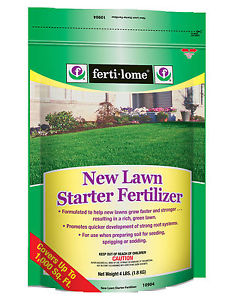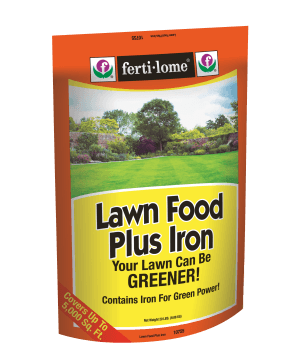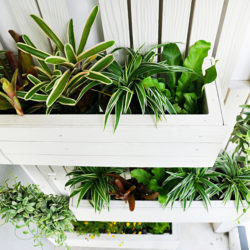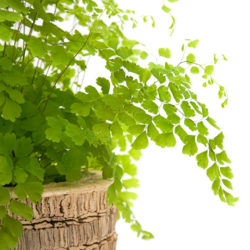Fall Is Best For Lawns
FALL IS THE BEST TIME TO SHOW YOUR LAWN SOME LOVE
What you do now has a big impact on the state of your lawn next spring.
Believe it or not, FALL is actually the best time to restore or renovate your lawn. Cooler temperatures, warm soil, sunshine and precipitation are the ideal components for your best lawn ever next spring.
Depending on the state of your lawn, and what you did last spring, your plan for August and September will vary.
WEEDS IN AUGUST
If you plan to restore your lawn this fall, and weeds are an issue, begin with a weed control product. Keep in mind, if you plan to seed in September (which is the best time to do it) you need about 2 weeks between spraying or applying any weed control product and seeding your lawn.
Ferti•lome® Weed-Free Zone, a post-emergent weed killer, is effective at temperatures between 45 degrees and 90 degrees. It contains ingredients that combat over 80 of the toughest to control broadleaf weeds in lawns including Clover, Ground Ivy, Spurge, Chickweed, Dandelion, Genbit, Oxalis, Poison Ivy, Purslane, Shepherds Purse, Thistle, Virginia Buttonweed, Wild Onion, and many others listed on the label.
Weed-Free Zone is fast acting and rain-fast in as little as 3 hours. For more info visit MAKE YOUR YARD A WEED-FREE ZONE
Roundup® is another effective product for targeted weed control in the lawn (and landscape). It kills existing weeds down to the root. Apply in sunny, dry conditions for the best results. You should see a difference in about 3 hours. Roundup is rainproof in only 10 miniutes. CLICK FOR MORE INFORMATION
SEPTEMBER » ESTABLISHED LAWNS
Apply Ferti•lome® Lawn Food Plus Iron, a good all-around lawn food with iron and nitrogen for greening and long term stable growth. Your existing lawn will thicken and green-
up in a jiffy. This is Step 2 of your yearly Ferti•lome® 3-Step Lawn Fertilization Program. Apply again in November to strengthen roots and ensure a quick green-up in the spring.
» STEP 1: (Spring) Ferti•lome® For All Seasons Lawn Food Plus Crabgrass and Weed Preventer –
Apply in early spring to control of grassy and broadleaf weeds.
» STEP 2: Ferti•lome® Lawn Food Plus Iron – September
» STEP 3: Ferti•lome® Lawn Food Plus Iron again in November
SEPTEMBER » TO SEED OR NOT TO SEED?
If the answer is to seed – September is the time to do it.
 If your lawn is merely thin, over-seeding will give you the plush lawn you’re looking for. If you only have a few thin or barren areas, you may need to simply spot seed.
If your lawn is merely thin, over-seeding will give you the plush lawn you’re looking for. If you only have a few thin or barren areas, you may need to simply spot seed.
To over-seed your lawn, or patch bare spots, mow first on a low setting. Use a bow rake or thatching rake to remove the buildup of dead vegetation and debris that accumulates above the soil surface, at the base of the blades. Raking also helps aerate the soil, which allows oxygen, water and fertilizer to reach seeds and newly sprouted blades.
A thin layer of thatch is beneficial, however, as it returns nitrogen to the soil as it decomposes. It also provides a buffer from changing temperatures. A layer more than 1/2” thick can inhibit water and fertilizer from reaching the roots. This causes grass roots to grow into the thatch layer where they are more vulnerable to dry conditions.
Using a spreader helps create an even covering of seed throughout the entire lawn. Seed or over-seed with a premium mix such as our signature blend, Delhi Fescue, a-turf top quality grass seed mixed with our local environment in mind. When seeding, apply Ferti•lome® New Lawn Starter Fertilizer. Its special formulation ensures your grass seed has the essential nutrients for developmental growth in these early stages. Water well but avoid creating puddles that wash away seed. Keep the area consistently moist for 2 to 3 weeks to ensure germination. Dry seed will not germinate so water daily if needed.
To patch a small, bare area, remove dead grass and add soil as needed. Add seed and fertilizer, then cover lightly with additional soil. A thin covering of straw will add protection. Keep these areas moist until the seed has germinated, removing any heavy clumps of straw when the new blades appear.
Raise mower to standard mowing height (about 3”) and mow new grass when it reaches approximately 4” in height, then maintain it as you do the rest of your lawn.
For newly emerged grass blades, mow twice before applying Ferti•lome® Weed-Free Zone to the area.
Don’t wait until next year to show your lawn some love. Seeding, feeding, and weed control this fall will give you a head start on the lawn you’ve always wanted next spring!
SEPTEMBER SEEDING TIPS
» STEP 1: Spread Delhi Fescue Blend quality grass seed to thicken lawn or patch bare spots.
» STEP 2: Ferti•lome® New Lawn Starter Fertilizer – Designed to help grass seed develop roots and mature stems. A must for new lawns
» STEP 3: After mowing new lawn at least twice apply Ferti•lome® Weed-Free Zone at temperatures 90 degrees and below to 45 degrees.





